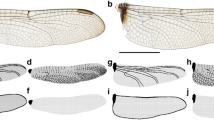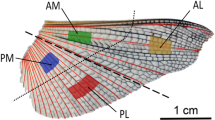Abstract
This study examined the morphological characteristics and mechanical properties of the wings of Tirumala limniace. The wings of this butterfly, including the forewings and hindwings, are composed mainly of a flexible wing membrane and supporting wing veins. Scanning electron microscopy was employed to observe specific positions of the wing membrane and veins and reveal the morphological characteristics. Tensile experiments were conducted to evaluate the mechanical properties of the wings and proved that the multifiber layer structures have a significantly fixed orientation of fiber alignment. A butterfly wing model reconstructed in reverse based on the finite element method was used to analyze the static characteristics of the wing structure in detail. Evaluation of stress and strain after applying uniform loading, perpendicular loading, and torsion revealed that minor wing deformation occurred and was concentrated near the main wing vein, which verifies the steadiness of the butterfly wing structure. Additionally, the flapping of butterfly wings was simulated using computational fluid dynamics to study the flow field near the butterfly wings and the distribution of pressure gradient on the wings. The results confirmed the effect of wing veins on maintaining the flight performance.







Similar content being viewed by others
Abbreviations
- A :
-
Original area of the cross-section
- CFD:
-
Computational fluid dynamics
- E :
-
Elastic modulus of the sample
- FEM:
-
Finite element modeling
- F :
-
Tensile force acting on the test sample
- F 0 :
-
Minimum lift in air
- F 1 :
-
Force applied to the wing tip
- h 0 :
-
Initial distance between the upper and lower clamps before the tensile test
- h i :
-
Actual length between the upper and lower fixtures at each stage of the experiment
- LEV:
-
Leading edge vortices
- L 1 :
-
Short diameter of the wing vein cross-section
- L 2 :
-
Long diameter of the wing vein cross-section
- l 0 :
-
Length of the butterfly wing in the span direction
- l 1 :
-
Length of the butterfly wing in the chord direction
- M :
-
Bending moment
- m 0 :
-
Mass of the insect
- q :
-
Uniform load
- S :
-
Area of a single wing
- SEM:
-
Scanning electron microscopy
- T :
-
Torque applied to the model
- ε i :
-
Strain of the sample
- σ :
-
Stress of the sample
References
Alejandro OA, Rodney E, Daniel V, Carter I, Michael S, Rob W, Mirko K (2006) Aerodynamic evaluation of wing shape and wing orientation in four butterfly species using numerical simulations and a low-speed wind tunnel, and its implications for the design of flying micro-robots. Interface Focus 7:20160087. https://doi.org/10.1098/rsfs.2016.0087
Bergou AJ, Ristroph L, Guckenheimer J, Cohen I, Wang ZJ (2010) Fruit flies modulate passive wing pitching to generate in-flight turns. Phys Rev Lett 104:148101.1-148101.4. https://doi.org/10.1103/PhysRevLett.104.148101
Birch JM, Dickinson MH (2001) Spanwise flow and the attachment of the leading-edge vortex on insect wings. Nature 412:729–733. https://doi.org/10.1038/35089071
Chen PY, Lin A, Lin YS, Meyers MA, Mckittrick J (2008) Structure and mechanical properties of selected biological materials. J Mech Behav Biomed 1(3):208–226. https://doi.org/10.7078/TSMHMNJN.201009.0135
Clercq KD, Kat RD, Remes B (2009). Flow visualization and force measurements on a hovering flapping-wing MAV ’DelFly II’. In: AIAA fluid dynamics conference, San Antonio. https://doi.org/10.2514/6.2009-4035
Dickinson MH, Lehmann FO, Sane SP (1999) Wing rotation and the aerodynamic basis of insect flight. Science 284:1954–1960. https://doi.org/10.1126/science.284.5422.1954
Dickson WB, Straw AD, Dickinson MH (2012) Integrative model of Drosophila flight. AIAA J 46:2150–2164. https://doi.org/10.2514/1.29862
Dudley R (2000) The biomechanics of insect flight: form, function, evolution. Ann Entomol Soc Am 93(5):307–308
Gorb SN, Kesel A, Berger J (2000) Microsculpture of the wing surface in Odonata: evidence for cuticular wax covering. Arthropod Struct Dev 29:129–135. https://doi.org/10.1016/S1467-8039(00)00020-7
Ha NS, Truong QT, Goo NS, Park HC (2013) Biomechanical properties of insect wings: the stress stiffening effects on the asymmetric bending of the Allomyrina dichotoma beetle’s hind wing. PLoS ONE 8:e80689. https://doi.org/10.1371/journal.pone.0080689
Haas F, Gorb S, Wootton RJ (2000) Elastic joints in dermapteran hind wings: materials and wing folding. Arthropod Struct Dev 29:137–146. https://doi.org/10.1016/S1467-8039(00)00025-6
Hepburn HR, Radloff SE (2004) The wing coupling apparatus and the morphometric analysis of honeybee populations. S Afr J Sci 100:565–570. https://doi.org/10.1109/OCEANS.1988.794859
Huang H, Sun M (2012) Forward flight of a model butterfly: simulation by equations of motion coupled with the Navier-Stokes equations. Acta Mech Sin 28:1–12. https://doi.org/10.1007/s10409-012-0209-1
Kesel AB, Philippi U, Nachtigall W (1998) Biomechanical aspects of the insect wing: an analysis using the finite element method. Comput Biol Med 28(4):423–437. https://doi.org/10.1016/S0010-4825(98)00018-3
Kukalova-Peck J (1987) Origin and evolution of insect wings and their relation to metamorphosis, as documented by the fossil record. J Morphol 156:53–125. https://doi.org/10.1002/jmor.1051560104
Li X, Guo C (2019a) Microstructure and material properties of hind wings of a bamboo weevil Cyrtotrachelus buqueti (Coleoptera: Curculionidae). Microsc Res Tech 82:1102–1113. https://doi.org/10.1002/jemt.23258
Li X, Guo C (2019b) Structural characteristics analysis of the hind wings in a bamboo weevil (Cyrtotrachelus buqueti). IET Nanobiotechnol 13:850–856. https://doi.org/10.1049/iet-nbt.2018.5409
Li LH, Guo C, Li X, Xu S, Han C (2017a) Microstructure and mechanical properties of rostrum in Cyrtotrachelus longimanus (Coleoptera: Curculionidae). Anim Cells Syst 21:199–206. https://doi.org/10.1080/19768354.2017.1330764
Li LH, Guo C, Li X, Han C (2017b) Morphology and nanoindentation properties of mouthparts in Cyrtotrachelus longimanus (Coleoptera:Curculionidae). Microsc Res Tech 80:704–711. https://doi.org/10.1002/jemt.22855
Lietz C, Schaber CF, Gorb SN, Rajabi H (2021) The damping and structural properties of dragonfly and damselfly wings during dynamic movement. Commun Biol 4:717. https://doi.org/10.1038/s42003-021-02263-2
Liu K, Jiang L (2011) Bio-inspired design of multiscale structures for function integration. Nano Today 6:155–175. https://doi.org/10.1016/j.nantod.2011.02.002
Machida K, Shimanuki J (2005) Structure analysis of the wing of a dragonfly. Proc SPIE 5852, Third International Conference on Experimental Mechanics and Third Conference of the Asian Committee on Experimental Mechanics, Singapore. pp. 671–676. https://doi.org/10.1117/12.621765
Michèle C, Bruno G, Alain V (2004) Patterns in evolution: veins of the Drosophila wing. Trends Genet 20:498–505. https://doi.org/10.1016/j.tig.2004.07.013
Noorhidayah M, Yazawa K, Kan N, Normarashid Y (2018) Morphological and mechanical properties of flexible resilin joints on damselfly wings (Rhinocypha spp.). PLoS ONE 13:e0193147. https://doi.org/10.1371/journal.pone.0193147
Ren LQ, Qiu ZM, Han ZW, Guan HY, Wu LY (2007) Experimental investigation on color variation mechanisms of structural light in Papilio maackii ménétriès butterfly wings. Science in China 50:430–436. https://doi.org/10.1007/s11431-007-0052-y
Sachs C, Fabritius H, Raabe D (2006) Experimental investigation of the elastic-plastic deformation of mineralized lobster cuticle by digital image correlation. J Struct Biol 155:409–425. https://doi.org/10.1016/j.jsb.2006.06.004
Sane SP, Dickinson MH (2001) The control of flight force by a flapping wing: lift and drag production. J Exp Biol 204:2607–2626. https://doi.org/10.1242/jeb.204.15.2607
Shen H, Ji AH, Li Q, Wang W, Qing GD, Han QF (2021) The unique strategies of flight initiation adopted by butterflies on vertical surfaces. J Bionic Eng 18:840–856. https://doi.org/10.1007/s42235-021-0061-8
Smith CW, Herbert R, Wootton RJ, Evans KE (2000) The hind wing of the desert locust (Schistocerca gregaria Forskål): II. Mechanical properties and functioning of the membrane. J Exp Biol 203:2933–2943. https://doi.org/10.1023/A:1008144208706
Song F, Lee KL, Soh AK, Zhu F, Bai YL (2004) Experimental studies of the material properties of the forewing of cicada (Homóptera Cicàdidae). J Exp Biol 207(17):3035–3042. https://doi.org/10.1242/jeb.01122
Sudo S (1996) Wing structure of dragonfly (second report). Trans JSME 62–599B:134–138. https://doi.org/10.1299/kikaic.64.3526
Sun M (2005) Dynamic flight stability of a hovering bumblebee. J Exp Biol 208:447–459. https://doi.org/10.1242/jeb.01407
Tsai CC, Childers RA, Shi NN (2020) Physical and behavioral adaptations to prevent overheating of the living wings of butterflies. Nat Commun 11:551. https://doi.org/10.1038/s41467-020-14408-8
Tuo W, Chen J, Wu Z, Xie J, Wang Y (2016) Characteristics of the tensile mechanical properties of fresh and dry forewings of beetles characteristics of the tensile mechanical properties of fresh and dry forewings of beetles. Mat Sci Eng C-Mater 65:51–58. https://doi.org/10.1016/j.msec.2016.04.025
Walker SM, Thomas ALR, Taylor GK (2009) Deformable wing kinematics in free-flying hoverflies. J R Soc Interface 7:131–142. https://doi.org/10.1098/rsif.2009.0120
Wang ZJ (2004) Unsteady forces and flows in low Reynolds number hovering flight: two-dimensional computations vs robotic wing experiments. J Exp Biol 207:449–460. https://doi.org/10.1242/jeb.00739
Weisman NY (2005) Regulation of development of wing venation in Drosophila melanogaster by a network of signalling pathways. Russ J Dev Biol 36:352–362. https://doi.org/10.1007/s11174-005-0051-5
Wood RJ (2007) Liftoff of a 60mg flapping-wing MAV. Intelligent robots and systems. Iros 2007. ieee/rsjinternational conferenceon. IEEE 2007:1889–1894. https://doi.org/10.1109/IROS.2007.4399502
Yokoyama N, Senda K, Iima M, Hirai N (2013) Aerodynamic forces and vortical structures in flapping butterfly’s forward flight. Phys Fluids 25:021902. https://doi.org/10.1063/1.4790882
Acknowledgements
All authors contributed to the study conception and design. The experimental setup was designed by AJ and HS. The material preparation, data collection, and analysis were performed by AJ, HS, XL, and YM. The first draft of the manuscript was written by HS. AJ, QL, and XL: contributed to data interpretation and critically revised the manuscript. All authors provided final approval for publication and agree to be held accountable for the work performed therein.
Funding
This work was supported by the National Natural Science of Foundation of China [grant numbers 51875281 and 51861135306].
Author information
Authors and Affiliations
Corresponding author
Ethics declarations
Conflict of interest
None.
Ethical approval
This study was carried out in accordance with the Guide for Laboratory Animal Management Ordinance of China. The experimental procedures were approved by the Jiangsu Association for Animal Science (Jiangsu, China).
Additional information
Handling Editor: Stanislav Gorb.
Publisher's Note
Springer Nature remains neutral with regard to jurisdictional claims in published maps and institutional affiliations.
Supplementary Information
Below is the link to the electronic supplementary material.
Supplementary file1 (AVI 373279 kb)
Rights and permissions
Springer Nature or its licensor holds exclusive rights to this article under a publishing agreement with the author(s) or other rightsholder(s); author self-archiving of the accepted manuscript version of this article is solely governed by the terms of such publishing agreement and applicable law.
About this article
Cite this article
Shen, H., Ji, A., Li, Q. et al. Tensile mechanical properties and finite element simulation of the wings of the butterfly Tirumala limniace. J Comp Physiol A 209, 239–251 (2023). https://doi.org/10.1007/s00359-022-01556-z
Received:
Revised:
Accepted:
Published:
Issue Date:
DOI: https://doi.org/10.1007/s00359-022-01556-z




